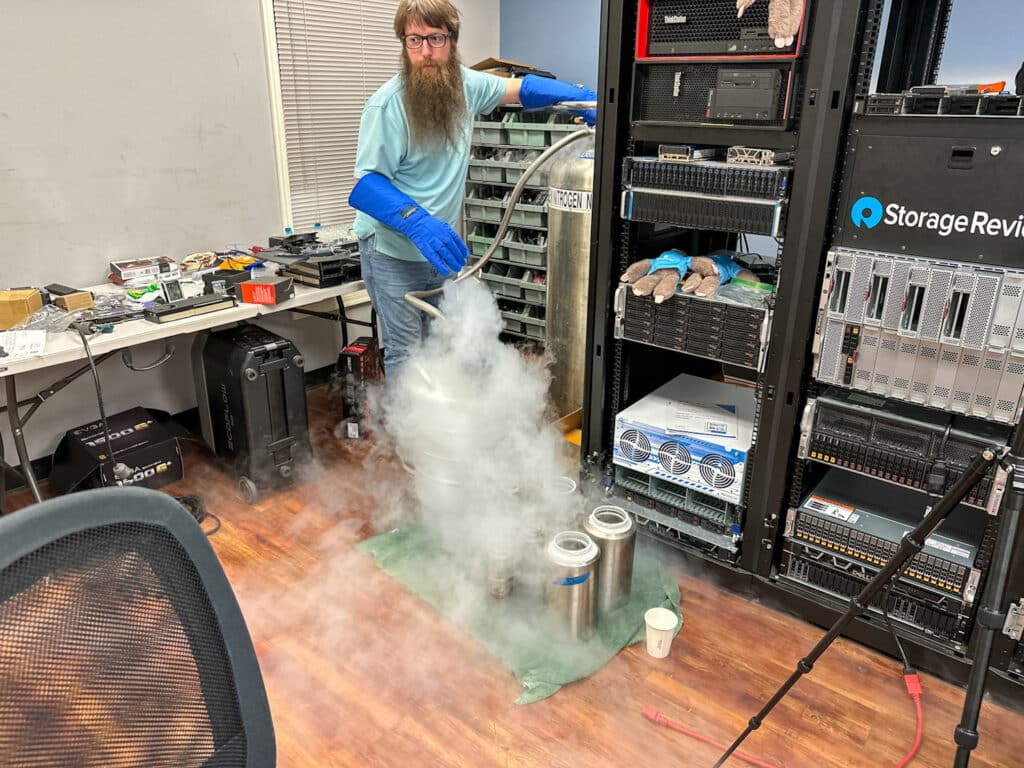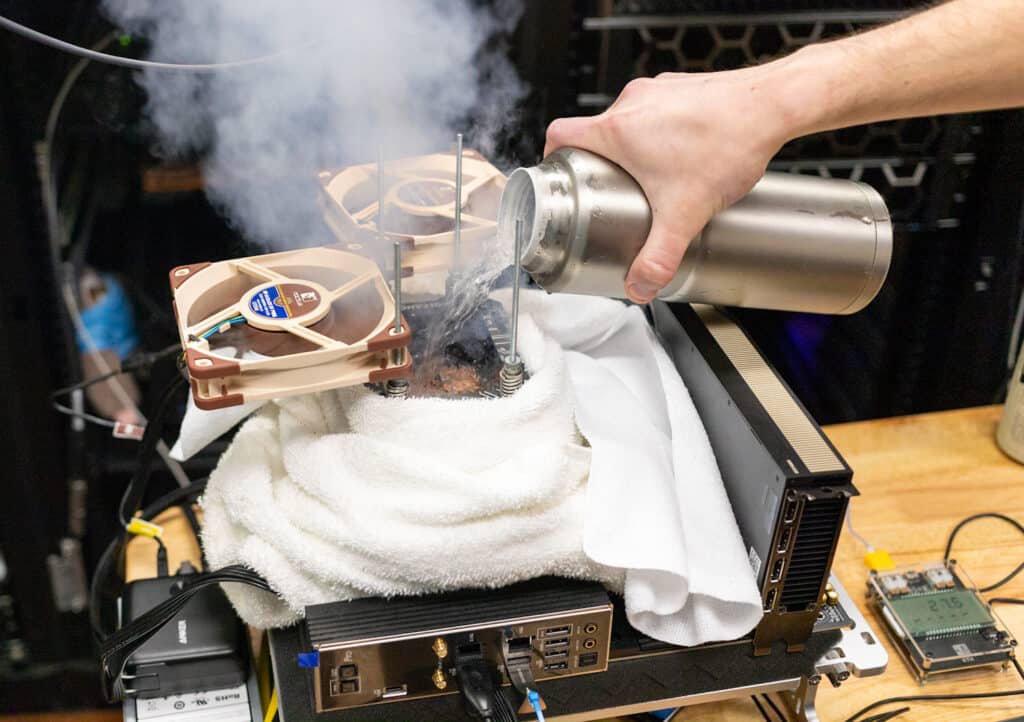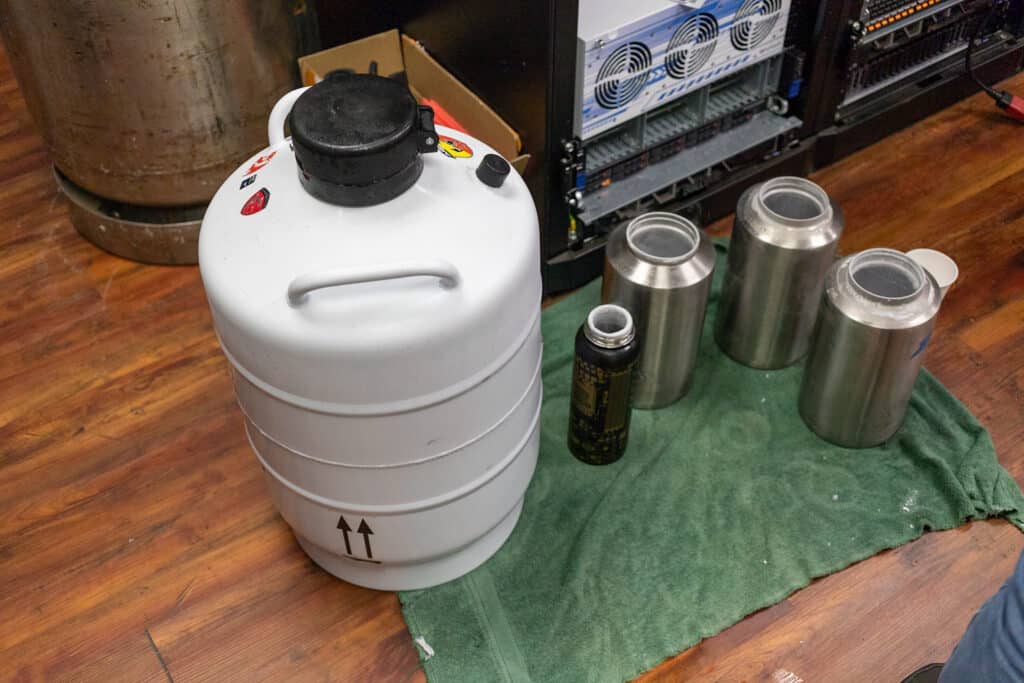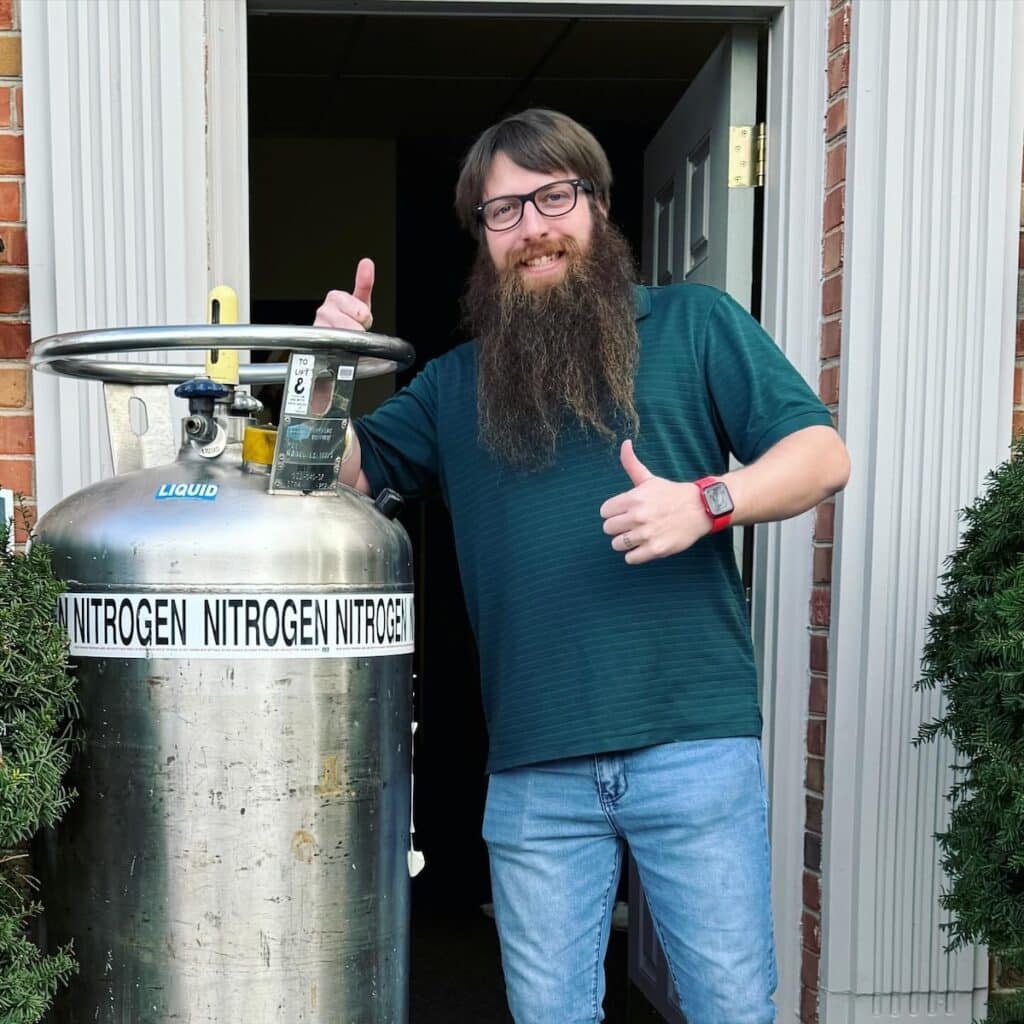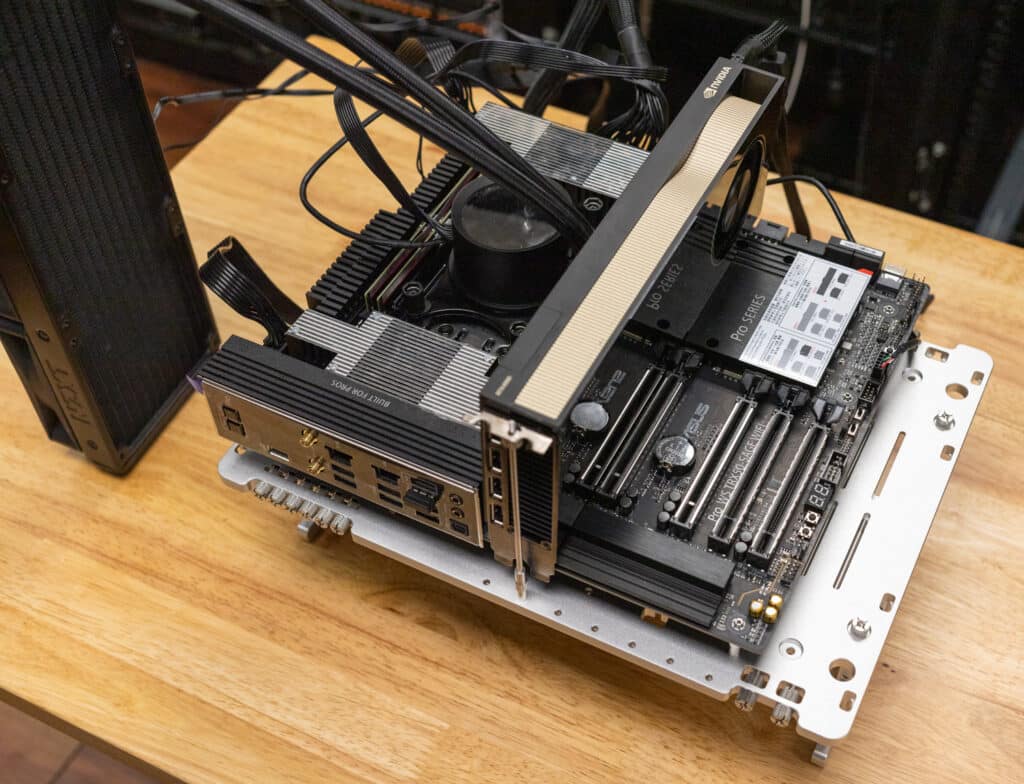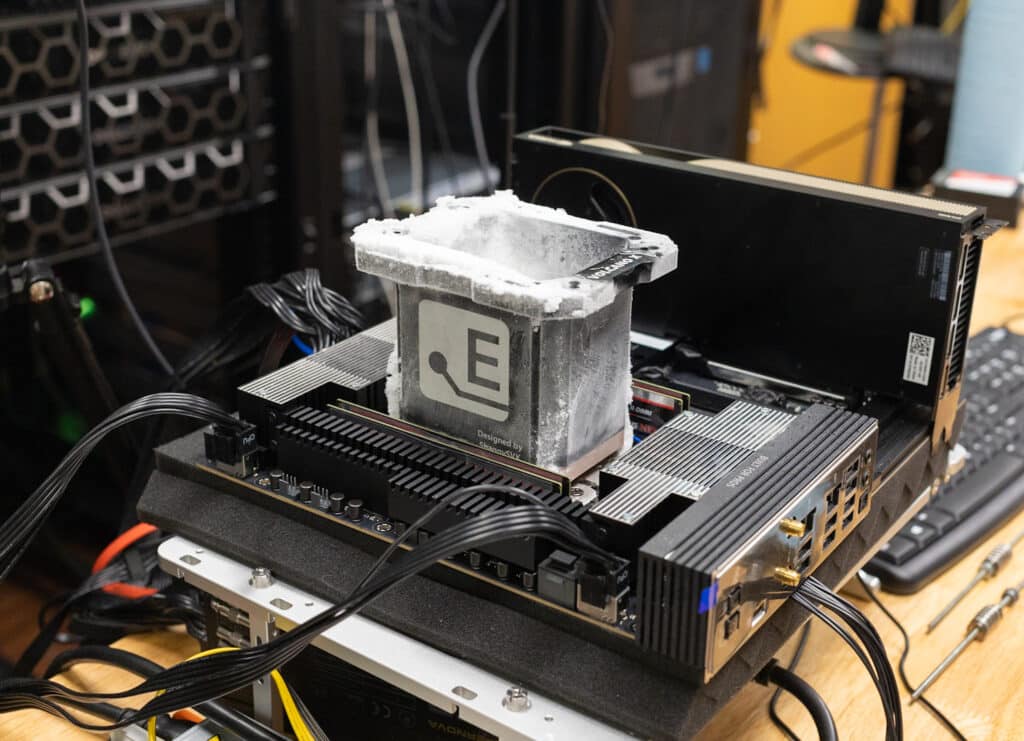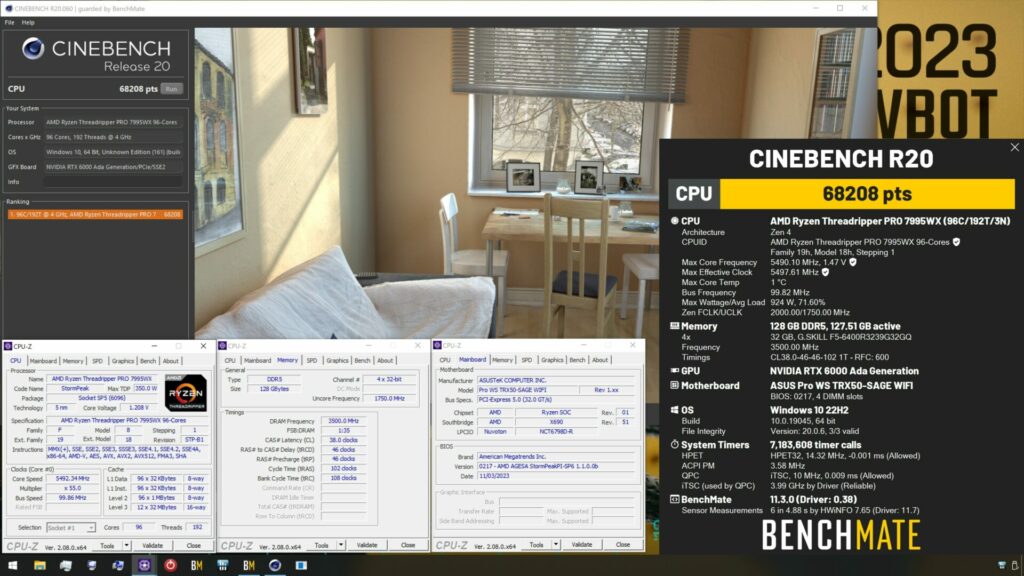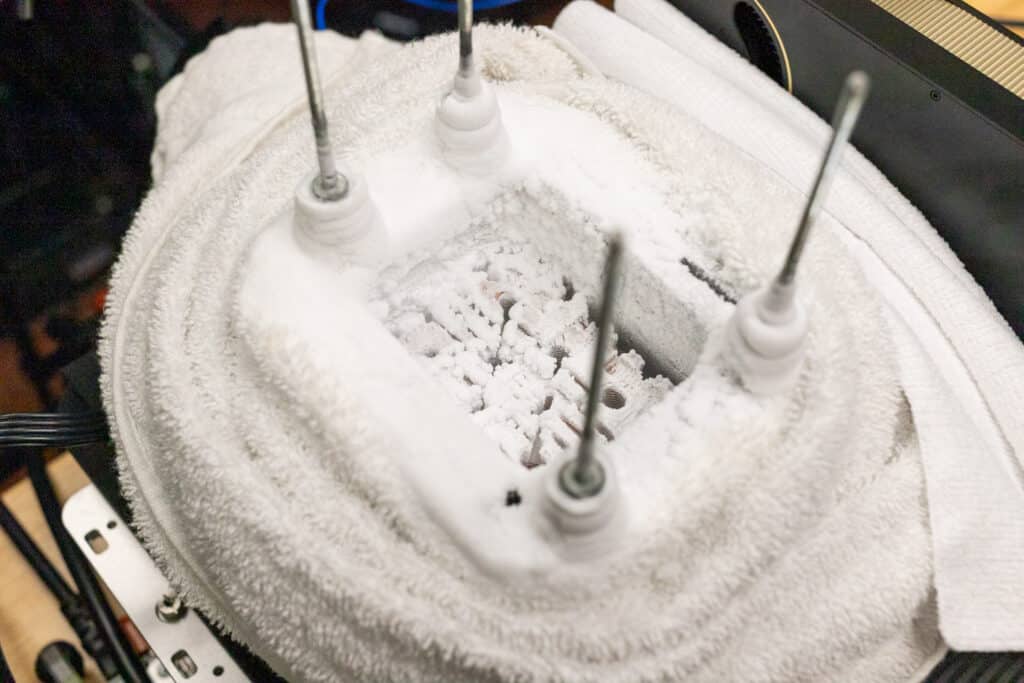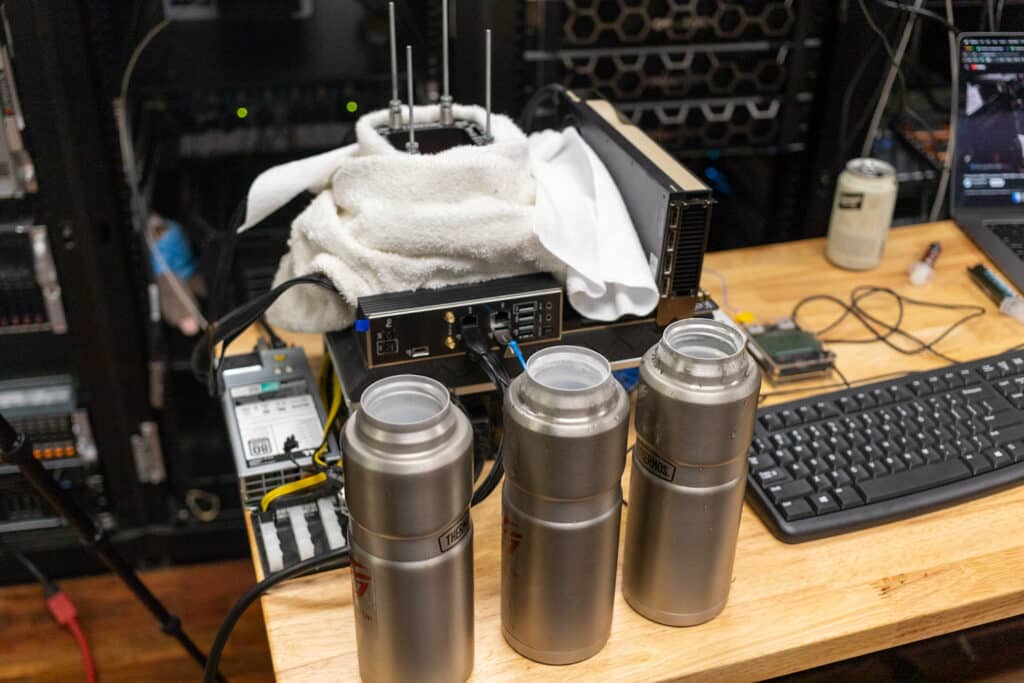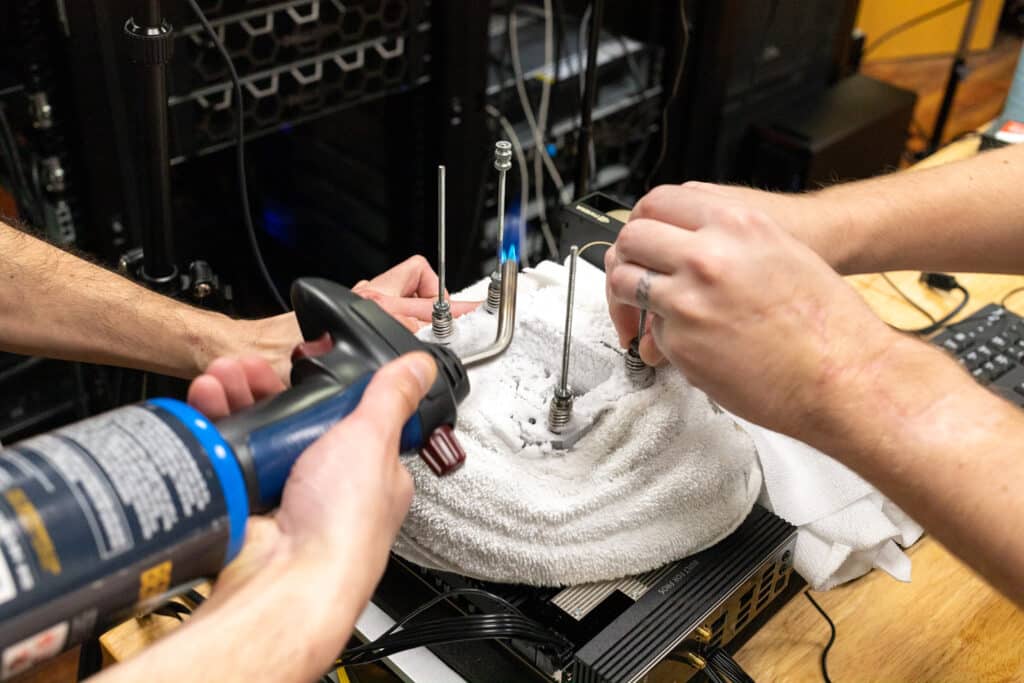In the spirit of trying out new things in the lab in our review of the AMD Threadripper 7000 Series HEDT and Workstation CPU’s, we decided that stopping at water-cooled overclocking was not extreme enough for the StorageReview lab, so we brought in some friends and decided to get cold, -195c cold. We wanted to see what a nice overclock and a couple of pours of liquid nitrogen could do to help push these chips to the edge, without destroying them along the way.
In the spirit of trying out new things in the lab in our review of the AMD Threadripper 7000 Series HEDT and Workstation CPU’s, we decided that stopping at water-cooled overclocking was not extreme enough for the StorageReview lab, so we brought in some friends and decided to get cold, -195c cold. We wanted to see what a nice overclock and a couple of pours of liquid nitrogen could do to help push these chips to the edge, without destroying them along the way.
Overclocking and the AMD Ryzen Threadripper 7000 Series
Overclocking has long been a pursuit for computer enthusiasts seeking to push their hardware beyond standard specifications. The AMD Ryzen Threadripper 7000 series, HEDT and Workstation, has an impressive range from 24 to 64 cores, and 96 on the Pro models, and impressive power efficiency, presents a fertile ground for such endeavors. These CPUs, which showed robust performance and temps in our stock testing, are ideal candidates for overclocking, particularly when using advanced cooling methods.
Liquid Nitrogen Overclocking
Liquid Nitrogen (LN2) overclocking stands at the extreme end of cooling techniques. LN2, with its extremely low temperatures of −195.8 °C (−320 °F, 77 K), allows CPUs to reach clock speeds and voltages otherwise unattainable under normal ambient cooling methods. This technique is particularly popular among those aiming to set new performance records.
Overclocking with LN2 requires stringent safety measures. Liquid nitrogen’s extremely low temperature (-196°C) demands respect and careful handling, including the use of protective gear and ensuring proper ventilation to avoid asphyxiation or burns.
Preparing for the Overclocking Adventure
With over 250 liters of liquid nitrogen delivered to the lab, it was time to get to business. The crack team of overclockers, BenchMarc, OneWolf, and TechTested joined us for this bringing together a combined nearly 5 decades of knowledge and hands-on experience with extreme OC, as well as the myriad of tools required to perform such a successful event.
The Elmor Labs Volcano X LN2 Pot is a specialized tool designed for LN2 overclocking. Its billet copper construction and drilled and slotted features facilitate efficient heat transfer and temperature control, crucial for throttling the LN2 pour to maintain stability during extreme overclocking sessions.
The Volcano Extreme was obviously the crown jewel of the project, but the little things like board heaters, extra power supplies, towels, blow torches, thermocouples, and screws all played a pivotal role in the process.
ASUS Pro WS TRX50-SAGE WIFI, Backbone of the Power
The ASUS Pro WS TRX50-SAGE WIFI AMD TR5 motherboard features a robust 36 power-stage design. This is crucial because when overclocking, especially with liquid nitrogen, the CPU demands an enormous amount of power. A standard motherboard would buckle under this pressure. The 36 power stages ensure that power is delivered smoothly and consistently, preventing fluctuations that could spell disaster at sub-zero temperatures.
These power stages are fed by two 8-pin power connectors, which is like having 3 car batteries worth of current available to the CPU. This design is paramount for stability during high overclocking, ensuring that each of the up to 96 cores in the Threadripper CPUs receives adequate power without the slightest hint of instability or power starvation.
The motherboard’s three PCIe 5.0 x16 slots, 10 Gb & 2.5 Gb LAN ports, and three M.2 slots offer ultrafast connectivity, ensuring that no bottleneck hampers the Threadripper’s performance. The server-grade IPMI remote management is a boon for real-time monitoring and tweaking, a feature as vital as the overclocking itself.
The Overclocking Process
Overclocking with LN2 is a delicate balance. It involves gradually lowering the CPU’s temperature with LN2 while monitoring performance and system stability. As temperatures drop, users can cautiously increase the CPU’s clock speeds, always keeping an eye on system metrics to prevent damage.
One critical aspect to consider during LN2 overclocking is the “Cold Bug,” a phenomenon where the CPU becomes unstable or can lock up entirely and fails to operate at extremely low temperatures. Each CPU model, and even different CPU’s in the same batch can have a different cold bug threshold, beyond which it won’t function correctly.
This is particularly important with the AMD Ryzen Threadripper 7000 series, as in our testing pushing the pot temperatures below -100c with liquid nitrogen can trigger this bug. We had to carefully monitor temperatures to avoid reaching this critical point, ensuring they maximize performance without crossing into the cold bug territory.
To mitigate the risk of icing and condensation, which can cause motherboard shorts, we employ a combination of fans, towels, and a heater. These elements work together to maintain an environment around the motherboard that prevents condensation accumulation. This protective measure is crucial, as the extreme cold introduced by LN2 can rapidly lead to moisture buildup, endangering the entire setup.
LN2 Benchmarking Success
Stability testing and benchmarking are crucial to quantify the performance improvements and ensure system stability. We used the standard suite in Benchmate to test our success.
We know you are anxious to see the results so here is the raw data table from the lab where Marc Portis (Forks) and I ran the LN2 benches.
| Benchmark | 7960x | OC GHz | 7970x | OC GHz | 7995wx | OC GHz |
| Core/Thread | 24/48 | 32/64 | 96/192 | |||
| Base | 4.2GHz | 4.0GHz | 2.5GHz | |||
| Boost | 5.3GHz | 5.3GHz | 5.1GHz | |||
| 7zip | 413,263 | 6.20 | 494,367 | 5.70 | 620,109 | 5.60 |
| Cinebench | ||||||
| R11.5 | 121.91 | 6.10 | Not Tested | 124.84 | 5.60 | |
| R15 | 10,802 | 6.10 | 13,267 | 5.80 | 26,127 | 5.60 |
| R20 | 25,634 | 6.10 | 31,513 | 5.80 | 68,208 | 5.50 |
| R23 Multi | 65,803 | 6.10 |
Not Tested
|
183,391 | 5.50 | |
| R24 | Not Tested | 8,641 | 5.50 | |||
| GeekBench | ||||||
| 3 Single | 190,812 | 6.10 |
Not Tested
|
Not Tested
|
||
| 3 Multi | 9,736 | 6.10 | ||||
| 4 Single | 9,710 | 6.10 | ||||
| 4 Multi | 119,702 | 6.10 | ||||
| 5 Single | 2,403 | 6.10 | ||||
| 5 Multi | 41,913 | 6.10 | ||||
| GPUPi 3.2 100M | 0.85 | 6.10 | Not Tested | 0.35 | 5.70 | |
| GPUPi 3.2 1B | 13.82 | 6.10 | 11.57 | 5.80 | 4.46 | 5.70 |
| GPUPi 3.3 100M | 0.83 | 6.10 |
Not Tested
|
Not Tested
|
||
| GPUPi 3.3 1B | 13.99 | 6.10 | ||||
| x265 1080p | 385.70 | 6.10 |
Not Tested
|
Not Tested
|
||
| x265 4k | 90.73 | 6.10 | ||||
| Superpi 1M | 5.44 | 6.10 | Not Tested | Not Tested | ||
| pifast | 12.75 | 6.10 |
Not Tested
|
Not Tested | ||
| wPrime 32m | 1.72 | 6.10 | 12.39 | 5.50 | ||
| wPrime 1024m | 14.60 | 6.10 | 2.29 | 5.50 | ||
| y-cruncher 1B | 7.70 | 6.10 | 6.99 |
Not Tested
|
||
| y-cruncher 25b | Not Tested | 263.66 | 4.80 |
Record-Breaking Endeavors
The Threadripper 7000 series, known for its high core count, has achieved some remarkable feats in our LN2 overclocking. These processors have shattered previous records, showcasing the incredible potential of AMD’s architecture when combined with extreme cooling solutions.
The gaps in the performance data table are attributed to several constraints encountered during our testing phase. Firstly, the looming embargo date imposed a tight timeline, significantly limiting the window available for comprehensive testing of each CPU. Such time constraints often result in a narrower scope of data collection.
Secondly, having only a single sample of each CPU model necessitated a cautious approach. We had to carefully manage the voltage levels and duration of exposure to LN2 to avoid risking the integrity of these valuable samples. Overly aggressive testing could lead to irreversible damage, thus a conservative strategy was adopted.
Lastly, the issue of icing or condensation on the motherboard posed a substantial risk. Prolonged exposure to the extreme cold of LN2 increases the likelihood of moisture buildup, which can lead to short circuits or other forms of damage to the motherboard. This phenomenon necessitated shorter testing periods and more intervals between sessions to allow the hardware to acclimatize and reduce moisture risk.
These factors collectively contributed to the limitations in our testing process, resulting in some gaps in the final performance data presented. Despite these challenges, the tests conducted provide valuable insights, albeit with the acknowledgment that the scope was constrained by these practical considerations.
Unleashing the Full Potential of the AMD Ryzen Threadripper 7000 Series
The heart of our extreme overclocking experiment lies in the results we’ve managed to achieve with the AMD Ryzen Threadripper 7000 series. Using liquid nitrogen (LN2) to push these chips to their limits, we’ve observed some significant performance jumps, highlighting the true potential of this hardware when combined with extreme cooling techniques.
- Cinebench R23: With an impressive 80% performance improvement one of the most notable achievements was with the 96-core Threadripper model in Cinebench R23, this is an astounding increase in performance compared to its base score.
- Cinebench R24: We achieved a 50% performance improvement in this test over the stock run.
- y-cruncher: 30% Faster Calculations in the benchmark, which is a demanding test for the whole system, not just the CPU, focusing on crunching Pi calculations, we managed to speed up the process by approximately 30%.
These performance improvements are not just numbers on a chart. They represent a significant stride in what is achievable with the right combination of high-end hardware and extreme cooling techniques.
It’s crucial to understand that these results were achieved not just by pouring LN2 over the CPU but through a carefully calibrated process of temperature control, voltage adjustment, and real-time monitoring. This process ensured that we went to the edge of performance from these CPUs without pushing them into the danger zone of permanent damage(read: chicken run).
Conclusion
In wrapping up this frosty fiasco with the AMD Ryzen Threadripper 7000 series, we’ve again proven that when it comes to benchmarking, we’re in a league of our own. Pushing these beasts with liquid nitrogen, we didn’t just nudge the limits – we blew them into the stratosphere(and thankfully kept the VRM attached to the board).
It’s not just about raw power; it’s about harnessing that power with the finesse only decades of experience and a sprinkle of genius can provide. The results? Stunning, to say the least. Sure, we had to dance around a few logistical hiccups and the ever-present threat of turning our precious CPUs into expensive paperweights. But, in the end, we demonstrated what’s possible when top-tier hardware meets extreme, and let’s be honest, slightly insane cooling methods. It’s not just overclocking; it’s art, and the crew we assembled for this testing are masters of this craft.
Engage with StorageReview
Newsletter | YouTube | Podcast iTunes/Spotify | Instagram | Twitter | TikTok | RSS Feed

